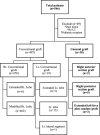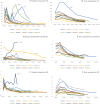Unusual grafts for living-donor liver transplantation
- PMID: 37875961
- PMCID: PMC10594742
- DOI: 10.1186/s40001-023-01428-5
Unusual grafts for living-donor liver transplantation
Abstract
Purpose: Unusual grafts, including extended left liver plus caudate lobe, right anterior section, and right posterior section grafts, are alternatives to left and right lobe grafts for living-donor liver transplantation. This study aimed to investigate unusual grafts from the perspectives of recipients and donors.
Methods: From 2016 to 2021, 497 patients received living-donor liver transplantation at Severance Hospital. Among them, 10 patients received unusual grafts. Three patients received extended left liver plus caudate lobe grafts, two patients received right anterior section grafts, and five patients received right posterior section grafts. Liver volumetrics and anatomy were analyzed for all recipients and donors. We collected data on laboratory examinations (alanine aminotransferase, total bilirubin, international normalized ratio), imaging studies, graft survival, and complications. A 1:2 ratio propensity-score matching method was used to reduce selection bias and balance variables between the unusual and conventional graft groups.
Results: The median of Model for End-stage Liver Disease score of unusual graft recipients was 13.5 (interquartile range 11.5-19.3) and that of graft-recipient weight ratio was 0.767 (0.7-0.9). ABO incompatibility was observed in four cases. The alanine aminotransferase level, total bilirubin level, and international normalized ratio decreased in both recipients and donors. Unusual and conventional grafts had similar survival rates (p = 0.492). The right and left subgroups did not differ from each counter-conventional subgroup (p = 0.339 and p = 0.695, respectively). The incidence of major complications was not significantly different between unusual and conventional graft recipients (p = 0.513). Wound seromas were reported by unusual graft donors; the complication ratio was similar to that in conventional graft donors (p = 0.169).
Conclusion: Although unusual grafts require a complex indication, they may show feasible surgical outcomes for recipients with an acceptable donor complication.
Keywords: Donor safety; Extended left liver plus caudate lobe graft; Right anterior section graft; Right posterior section graft; Surgical outcomes.
© 2023. BioMed Central Ltd., part of Springer Nature.
Conflict of interest statement
The authors have no conflicts of interest to declare.
Figures





References
MeSH terms
Substances
LinkOut - more resources
Full Text Sources
Medical

